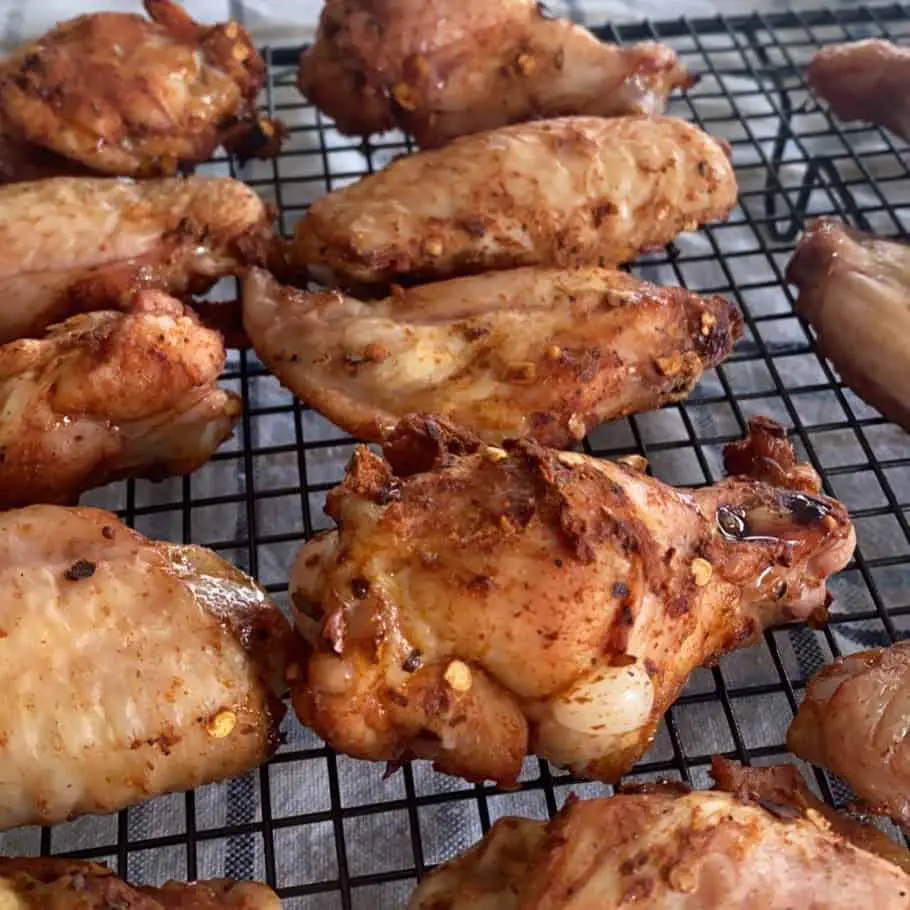I’m sure we’ve all had a time when you’ve bitten into the most amazing looking smoked chicken only to find yourself fighting with tough rubbery skin.
Although palatable, the sooner you find out what caused it, the sooner you can fix it and prevent rubbery skin on smoked chicken from happening entirely. By simply smoking chicken at a higher temperature and avoiding excess moisture on the skin you will immediately notice the difference in the taste and texture.
Here’s everything you need to know to prevent rubbery skin on your smoked chicken and enjoy a much crisper skin to really elevate your smoked chicken to championship levels.
What Causes Rubbery Skin On Smoked Chicken?

One of the most common issues reported when smoking chicken is getting rubbery, tough, and chewy skin. This isn’t a coincidence. It’s actually a process caused by slow cooking of the fat and moisture within the chicken skin.
The process of low and slow smoking is to effectively break down fat and connective tissue that connects the protein together, turning tough meat tender. Chicken doesn’t actually contain connective tissue and the meat is very lean in comparison. It’s because of this reason that chicken does not benefit from typical low and slow cooking.
Smoking at low temperatures between 225-275°F causes rubbery skin on smoked chicken as the fat and moisture in the skin remains intact and turns tough.
However, when smoking chicken at higher temperatures of between 300-350°F, you are able to enjoy the delicious smoky flavor, as well as crispy skin — opposed to rubbery. This is because the high temperatures dry out the chicken skin much more quickly. When all the moisture in the chicken skin is gone the fat caramelizes and the skin begins to shrink and crispen up!
This goes for other poultry too, like when avoiding rubbery skin on smoked turkey!
Can You Fix Rubbery Skin On Smoked Chicken?
If you’ve finished smoking your chicken and realized the skin is tough and rubbery, there are a few things you can do to try and salvage it.
The best way to try to fix rubbery skin on smoked chicken is to sear it skin-side down for one minute on a very hot grill or pan. Although this will inevitably cook your chicken a bit more, it will also help to caramelize the fat and remove the moisture from the skin. Plus — if you’re using a grill then you’ll be left with some beautifully appetizing sear lines across the skin.
This isn’t a foolproof method, but depending on the temperature and how long you’ve smoked your chicken it can certainly make a difference. This method works better for chicken wings, chicken thighs, or smoked chicken legs and less so for the leaner pieces of the chicken like the breast as it tends to dry it out too much.
If your chicken skin is already as rubbery as a leather boot, the next best way to salvage your chicken is to simply remove the skin. Although this will remove a lot of the seasoning and a bit of the smoke flavor, you can still enjoy your deliciously tender smoked chicken. If you have removed the skin, you can shred the chicken or carve it up to serve skinless. No harm done.
Tips To Prevent Rubbery Skin On Smoked Chicken
Between the preparation stage, smoking stage, and immediately after they’re done, there are several things you can do to prevent rubbery skin on your next smoked chicken, whether it’s a chicken leg quarter, drumstick, thigh, or you’re smoking chicken breast.
Don’t Smoke At Low Temperatures
Avoid smoking your chicken at any temperatures lower than 300°F. The fat within the chicken skin simply won’t render and the moisture will be trapped in the skin leading to tough and rubbery skin. Always smoke chicken at higher temperatures than 300°F. If you’re smoking chicken wings from frozen, 300°F will be the sweet spot.
Don’t Spritz Or Baste During The Cook
With other barbecue meats, basting or spritzing can be a good way to add more moisture, develop further flavor, or help add more smokey flavor, such as when spritzing brisket.
When it comes to chicken, there is no benefit of spritzing or basting during the cook, and if you do it’s much more likely the skin will become rubbery. During the smoking process you actually want the skin to dry out, removing all the moisture which helps the fat render properly and for the skin to crispen.
Dry The Chicken Skin
If you’re wet brining the chicken always thoroughly pat dry with a paper towel before adding any seasoning or rub. Better yet, try dry brining your chicken with plenty of salt. This will actually dehydrate the skin making it much more likely to become crispy and make it very unlikely to become rubbery!
If you notice your chicken wings have little hairs on them, you can optionally remove them at this stage, as they won’t often disintegrate if you are smoking them, unlike when you grill them at a high heat.
Don’t Wrap The Chicken
Wrapping meat in foil or butcher’s paper in the smoker helps the meat stay moist and quickens the cooking process as it prevents evaporation of the moisture on the surface of the meat which usually cools it down.
When you wrap your chicken when smoking it will effectively steam it. This moisture will gather on the skin which will turn crispy skin into soft and soggy skin. If it rehydrates the skin and continues cooking it will quickly become rubbery.
Use Dry Rub Instead Of Wet Marinade
When you’re cooking skin-on chicken, whether it’s smoked chicken thighs, smoked chicken quarters or the whole chook, always use a dry rub or dry seasoning rather than lathering it with marinade.
Don’t get me wrong though, smoking marinated chicken can still come out amazing. But it tends to work so much better on skinless chicken. You can try tandoori smoked chicken thigh, peri-peri smoked chicken wings, or lemon & garlic smoked chicken breast.
If you want the dry rub to adhere to the chicken, use a bit of oil and lemon or lime juice. The acidic juice will actually help the skin crispen up too!
How To Get Crispy Skin When Smoking Chicken
So how do you avoid rubbery skin and get the highly sought after crispy skin that every chicken lover dreams of? Whether your smoking a whole chicken, chicken thighs, chicken breasts, or smoking chicken wings the key to getting crispy skin is:
1) Keeping It Dry Throughout The Process:
The sooner the skin loses its moisture and dehydrates, the more easily the fat will render, and the sooner the skin will begin to crispen. Some cooks use citrus fruits to provide acidity which also helps the skin become crispy, and some use cornstarch or salt to help dry it out. Although these may help, the key is just to keep it dry during the preparation and throughout the smoking process.
2) Smoking At A Consistently Hot Temperature:
Low temperatures are no good for chicken skin. Make sure you crank up the heat to at least 300°F for the entirety of the cook. Although the chicken will cook faster and absorb less smoke, you will be rewarded with deliciously crispy skin that’s far from tough smoked chicken skin.
3) Finishing The Chicken At A Higher Temperature:
Something that really helps take the chicken skin to the next level is by finishing it at a much higher temperature. You can do this by increasing the temperature to 450°F in your smoker for the last 15-30 minutes. If you want to go the extra mile, you can fire up your grill instead and sear the chicken skin-side down for 30 seconds to a minute at a very high temperature.
Final Words
As always, I love to keep it simple. When it comes to barbecue don’t over complicate things, let food be food. To avoid rubbery chicken skin be sure to smoke it at a much higher temperature. Put away the barbecue spray bottle, you don’t need to spritz, baste, or cover your chicken. Stick to the basics and control the temperature and smoke and you will be justly rewarded with crispy chicken skin.
Happy smoking!


5 thoughts on “Preventing Rubbery Skin On Smoked Chicken”
Excellent article.
Thanks Bobby
Sounds like you will be enjoying crispy chicken skin 😉
I just got a smoker and the first night I set it up, I made chicken wings. The recipe called for using a temp of 250, but since I didn’t want to make my wife wait till midnight to eat, I cheated and put the temp at 350. The wings came out phenomenal. The next time I made wings, I did it the “right” way, by the recipe book at 250. They came out very rubbery! I didn’t know what was wrong, but seeing this article makes lots of sense, I had the temperature too low and the book I bought is wrong!
Hey David,
Glad you got to the bottom of it. It still amazes me how many recipes call for low temperatures of 225-250°F for chicken, particularly chicken wings.
These recipes should come with a warning that you’ll be left with rubbery skin!
🙂
Your article is a complete blessing for this gal brand new to smoking. Thanks!